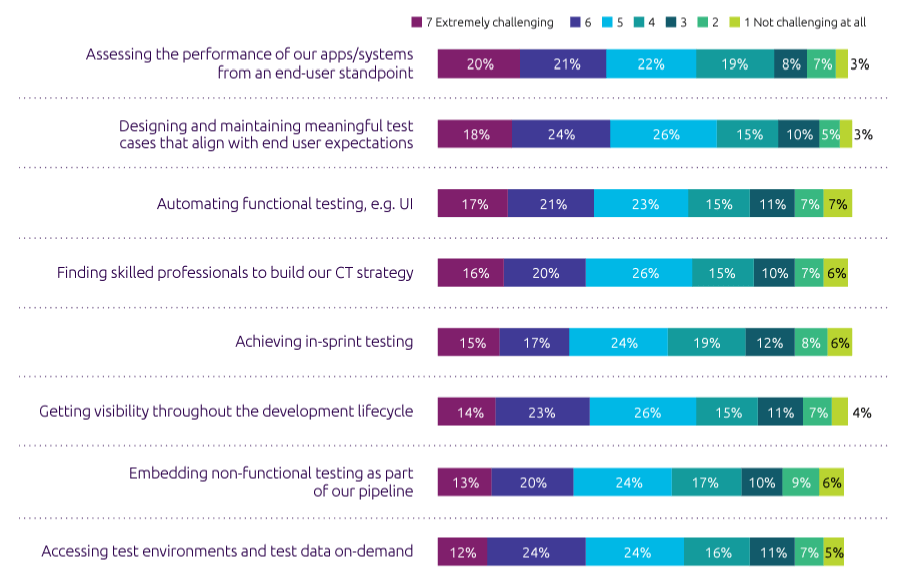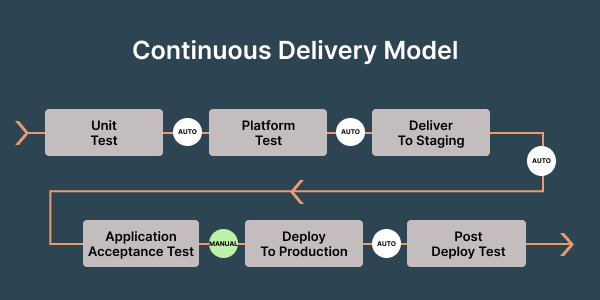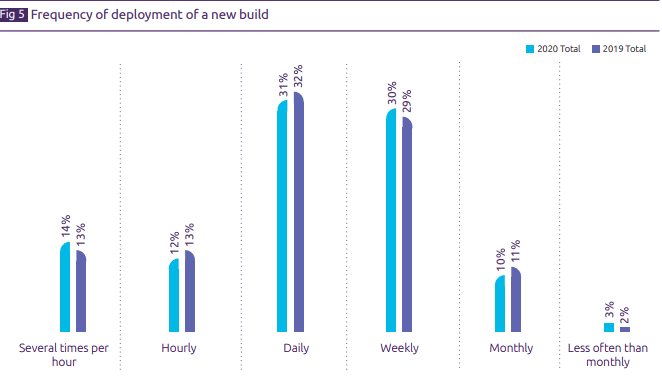Test Orchestration: What, Why, and How?
Sarafadeen Ibrahim Ayomide
Posted On: September 29, 2022
![]() 148822 Views
148822 Views
![]() 15 Min Read
15 Min Read
Automated testing strengthens the continuous testing cycle by reducing human intervention, thereby reducing error frequency. Test scripts, scalable & reliable test infrastructure, and efficient test data are the major building blocks of automated testing and have since become central to the continuous testing cycle.
Asynchronous progression is a common feature in automation testing, especially used during the process of end to end testing. Although effective, it does not provide total visibility into the continuous testing cycle. The fact that 78% of businesses cite visibility as their biggest challenge in continuous testing indicates the need for a testing framework that provides such. This unmatched insight and complete visibility are provided by test orchestration.

If DevOps were a coin, test automation and test orchestration would be the two sides. Test orchestration enables the grouping and intelligent distribution of automated tests across runner environments. The CI pipeline functions more smoothly with test orchestration, allowing us to deliver software continuously (i.e., Continuous Delivery). In this test orchestration tutorial, we go into the minutiae of test orchestration.
Let’s get started…
TABLE OF CONTENTS
- What is test orchestration?
- What are the components of an effective test orchestration system?
- Test orchestration’s use cases
- What are the benefits of test orchestration?
- How to prepare an effective test orchestration framework?
- End to end testing using test orchestration
- Frequently Asked Questions (FAQs)
What is test orchestration?
Test orchestration is the arrangement of automated tests into a sequence for execution to enable efficient monitoring and test execution. Automation alone is not sufficient for continuous testing to succeed. The automated tests must proceed streamlined while maintaining self-sufficiency and agility. With the aid of test orchestration, you can continuously execute your tests in many environments in a prepared and automated manner, providing you with a complete picture of the state of your tests.
The software is put through various tests after each development cycle. These include unit testing and many other automated tests for better test coverage. However, they still need the relevant input data and to be activated at the appropriate time. Test orchestration makes the testing cycle intelligent by integrating all of these independently automated tests into a sequential order for execution.
What are the components of an effective test orchestration system?
“As orchestration practices improve, organizations will want to work towards a connected ecosystem that integrates release management, requirements, design, build, test, and deployment.” — Capgemini Continuous Testing report.
Despite the fact that test orchestration is the cornerstone of an automation testing framework, it also contains components of its own. A thoroughly orchestrated pipeline will contain:
Super-optimized continuous delivery pipeline
Deploying code to a production environment without manual intervention is known as continuous delivery (CD).
Before distributing software updates to the customer, developers use continuous delivery to automate numerous tests to validate various elements of the changes. API testing, user interface testing, and other testings relevant to the product are automatically run.
During CD, code is written into continuous integration (CI) pipeline, which is versioned into a repository as soon as the code passes specific tests. A continuous delivery pipeline with testing and monitoring integrated into a single ecosystem with 100% availability is a requirement for a test orchestration framework.

Adaptive test scripts
An enormous burden, especially for large-scale projects, is maintaining the test scripts for automated test cases. Each time a functionality change is implemented, the associated test cases might also undergo some (and/or major) changes. Finding the affected test cases, changing them, and then re-verifying them is a difficult and error-prone procedure.
The test scripts in the test orchestration pipeline must be adaptable to every change in functionality, tooling, or user interface (UI) because the goal of test orchestration is to tighten the grip on the test execution.
Real-time test data generation
The generation of test data presents a significant challenge for automated testing. Test script execution expects test data to be in a certain state. For instance, in end-to-end testing, the tests might be dependent, and multiple scripts representing different test scenarios may need to access the same data simultaneously. As each script accesses and modifies the data, the data might be affected, which may lead to the test failure of another script.
An effective test data generation technique can deliver compliant test data on demand, eliminating these possibilities. The tests are independently executed and progress as stand-alone scenarios with personalized data for each.
Automated code resiliency
Businesses believe they have enough automation because, according to around two-thirds of World Quality Report respondents, they have the necessary tools and enough time to create automation tests. However, according to respondents, just 15% of tests were automated on average, and only 3% of businesses automated more than 20% of tests.
If the release candidate fails, the code base may be quickly restored to the prior version, thanks to the increased resilience of well-implemented automation. As a result, testing requires less time, covers more software, produces better problem identification, and there is faster feedback.
Continuous monitoring
Continuous monitoring is the technique of detecting risks to the standards of a software development cycle and architecture. It can be used to find discrepancies in software and is also known as continuous control monitoring or CCM. Continuous monitoring improves the SDLC’s performance, user experience, and transparency.
Information about an application is provided via continuous monitoring, including the application’s uptime, security, performance, and log time. To understand how effectively the program operates, the reports are primarily generated using statistics and graphs. A continuous monitoring pipeline with uninterrupted validation and health checks of services run uninterruptedly to detect issues in real-time is key to the success of the test orchestration framework.
Test orchestration’s use cases
Delivery teams can take a risk-based strategy by using test orchestration, which enables them to concentrate more on testing’s more complex components, such as test data management, continuous monitoring, and output analysis. Delivery teams can orchestrate tests in the following instances:
Upgrade testing
A certain software version may be upgraded (through several routes) from many earlier versions. For high quality, testing each of those upgrades is a must. Test orchestration allows for intelligent testing of the software release across different upgrade paths and multiple running environments.
Specialized testing
Test orchestration is a framework that delivery teams can use for specialized tests, such as security testing. When security tests are streamlined intelligently through orchestration, the software’s security vulnerabilities are discovered in a measured manner.
End-to-end testing
Using test orchestration, complicated test scenarios that include numerous API combinations and services executed one after another to produce a quantifiable result can be tested.
What are the benefits of test orchestration?
Automated testing that occurs asynchronously causes entropy and other issues that raise TTM, slow development and demotivate developers. These issues are eliminated through test orchestration, which offers a variety of benefits:
Better visibility into release cycles
The significance of test orchestration cannot be overemphasized, with more than 78% of businesses reporting that gaining visibility into the testing ecosystem is their top difficulty during continuous testing.
Visibility into the software release cycle is essential because it enables you to identify and address bottlenecks early on, improving software quality and shortening time to market. The DevOps team can convert the input and output data obtained through test orchestration into key performance indicators (KPIs). The software team can then use these KPIs to allocate roles and determine their next course of action. For example, video reports can identify and address any bugs hindering a software’s quality rating.
You can use the reports and artefacts generated by test orchestration to support testing activities and the decisions that go along with them. These artefacts are also usable in establishing common benchmarks or criteria that can serve as quality gates in the continuous delivery pipeline.
Faster feedback loop
Asynchronous test execution results in many errors, testing failures, and sluggish feedback loops, among other things. Due to them, developer motivation declines, and a report claims that developer motivation accounts for 41% of the delays in a software release. This emphasizes the need for the development team to be agile and motivated, which test orchestration helps with.
Test orchestration reduces manual intervention in the testing cycle, which lowers the likelihood of errors and accelerates feedback. These give the software testing life cycle self-sustainability, allowing for fewer execution failures.
Fail early, Fix easily
Early in the delivery cycle, when a test case fails, it is significantly simpler and less complex to fix the problems.
It increases shift-left adoption
According to research, new builds are taking place more quickly than ever, with 31% of businesses stating that new builds are developed daily. While this precipitation in new builds reflects enhanced flexibility of the release cycle, it also points to an increase in the quantity and load of automated tests. Hence, test orchestration is now more crucial than ever.

A “test as you build” approach to testing, which is the fundamental rationale behind the shift-left testing approach, is ultimately necessary given the anticipated increase in testing and error frequency. Testing proceeds more quickly, and the goal of the shift-left method of software development is achieved more quickly when the tests are orchestrated.
Test orchestration drives continuous delivery to maturity
Continuous delivery, the cornerstone of DevOps, is powered by automation. Automation facilitates the creation of a single source of truth for all parties involved in software development, which speeds up communication and teamwork.
Test orchestration spikes the benefits you can expect to reap from test automation. As a result, incorporating test orchestration into the CI/CD pipeline ensures that the primary objectives of CI/CD implementation are achieved.
Enable continuous test orchestration and execution on cloud. Try LambdaTest Now!
How to prepare an effective test orchestration framework?
Despite the incredible advantages test orchestration offers, it is not without difficulties. Follow these tips when preparing your test orchestration framework:
Select the right tools
The first step in creating a framework for test orchestration is choosing the tools. There are particular tools suitable for each pipeline component that is efficiently orchestrated. The holy grail of tool selection, like other parts of continuous testing, is to choose tools that are best suited for your orchestration goals and tools that will offer the data you need in the format you need to make decisions.
For instance, the orchestration goal of an e-commerce company may demand video analytics on the cart selection and ordering capabilities of the software. It will be challenging, and the company might not realize the tremendous ROI of test orchestration if it chooses an orchestration tool that exclusively offers test reports in the form of charts and quantitative data.
Without manual intervention, the right tools can affect the accuracy of the test results. The tools required to create synthetic or real-time data differ from those needed to generate and load data for the performance tests. You can also write and add adaptive test scripts to the test orchestration pipeline without tools that function in accordance with the needs of the pipeline.
Choose a tool compatible with your CI/CD pipeline, as it will bolster the release cycle by preventing integration problems. To reduce the time spent orchestrating the tests, it is essential to use a tool with smart workflow capabilities like automatic sequencing, status and dynamic test discovery, and intelligent test retries. A tool that can operate in several environments, such as Linux containers, macOS, etc., is also crucial.
Establish a measurable purpose
Clarity of purpose is fundamental to the success of any test orchestration framework. It makes it easier for all teams to work together to target every sequenced step towards a certain result. There are various benefits of test orchestration outside the better quality and speed of feedback that is the intended overall result.
For instance, a test orchestration pipeline can be configured to fire up before each product release and run UI testing under varied loads. The performance data and suggestions on how to configure the application for greater output are among the anticipated results. The test orchestration’s goal aids in determining the extent of test automation planned for and accomplished in that direction.
End to end testing using test orchestration
HyperExecute is an intelligent test orchestration platform by LambdaTest that allows for the fastest end-to-end Selenium testing. Through the provision of test infrastructure with the best possible speed, test orchestration, and unified execution logs, HyperExecute enables you to reduce your software’s TTM. Thus, you can test the code and address problems much more quickly.
You can also Subscribe to the LambdaTest YouTube Channel and stay updated with the latest tutorials around Selenium testing, Cypress E2E testing, CI/CD, and more.
A YAML file is used to configure HyperExecute. By combining all the aforementioned orchestration components into a single execution environment, it streamlines the entire orchestration pipeline. There are four distinct things that particularise HyperExecute:
Support for multiple orchestration mechanisms
HyperExecute supports multiple orchestration mechanisms, including Matrix-based Build Multiplexing and Smart Auto Test Splitting. You can orchestrate and customize parallel tests using Smart Auto Test Splitting. The test discovery component of the YAML file allows you to instruct HyperExecute to discover certain tests in the pipeline and feed the output into specified tests. You can also modify the concurrent test execution builds.
By building a matrix of all the possible combinations, matrix-based build multiplexing enables users to run a single command over various scenarios, settings, and environments. Regression testing benefits the most because it improves coverage and results in a resilient codebase.
Automatic reordering of tests
In case of a test execution failure, synchronous test execution is interrupted in a conventional orchestration platform. This necessitates manual reordering and reconfiguration of the test sequence.
But HyperExecute detects test failures, automatically reorders the test, and logs the failure as soon as it happens. This provides proof of HyperExecute’s self-sustainability and quick feedback reporting, which were previously mentioned as crucial for efficient test orchestration.
The Command Line Interface
In addition to offering a variety of other helpful capabilities that speed up test execution, HyperExecute CLI is a command line client to communicate with and run tests on HyperExecute. You must obtain the HyperExecute CLI binary for the platform (or OS) on which the tests are run to trigger tests using the HyperExecute CLI.
You can personalize the HyperExecute experience by using the many command-line flags offered by the HyperExecute CLI. A number of features are available to you after installing the HyperExecute CLI on your computer. You can examine the various flags, for instance, by using the hyperexecute.exe —help command. You can also create and download artifacts using the CLI.
Support for frameworks and languages
You can orchestrate your Selenium tests with HyperExecute in many languages and frameworks. For instance, JUnit, Java, and many more languages allow you to create test scripts and sequence tests.
Unification of logs
Fusing terminal and test execution logs in legacy test clouds is an ETL headache. You receive a single automation dashboard view with HyperExecute that includes both terminal logs of test command execution and comprehensive test execution logs. A single user-friendly dashboard contains all test execution data, including terminal logs, test run videos, network logs, commands, exceptions, and more.
Automatic Report Generation
Because all test execution data is available in a single location, HyperExecute enables developers and testers to examine the quality of their builds on a single platform through insightful automatic reports created for each build run. This removes the need to develop intricate reporting frameworks and collect data from many sources.
Checkout LambdaTest HyperExecute on Microsoft Azure marketplace
Conclusion
55% of businesses claim that they typically end up with far more test cases than necessary, with lots of overlap, because their tests are not modelled on their business needs but some generic vanity metrics. Consequently, it is about time businesses start orchestrating their tests to give them complete visibility into the continuous testing cycle, reduce redundancy in the CT cycle, and allow them to base their business decisions and test cases on their business needs.
In this blog on test orchestration, we’ve gone over a walkthrough of the test orchestration pipeline’s finer points and looked at how the HyperExecute test orchestration grid helps reimagine the process.
Frequently Asked Questions (FAQs)
What does orchestration mean in DevOps?
Orchestration, in the context of DevOps and related disciplines, is a type of automation that orchestrates various processes to increase efficiency and reduce production issues. While DevOps is concerned with automating the entire software development cycle, it is also interested in automating certain processes within the larger picture.
What is orchestration vs automation?
Orchestration, while similar to automation, is a concept that falls under the DevOps umbrella. It’s the process of automating tasks rather than specific actions within them. While automation is the capacity to do something repeatedly, orchestration is the capacity to do many things simultaneously.
Got Questions? Drop them on LambdaTest Community. Visit now

















